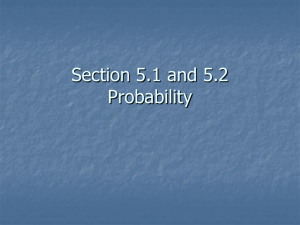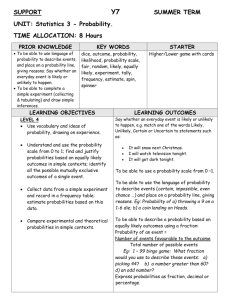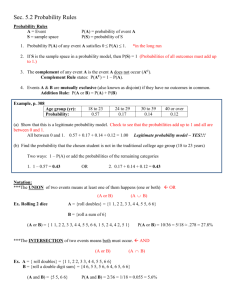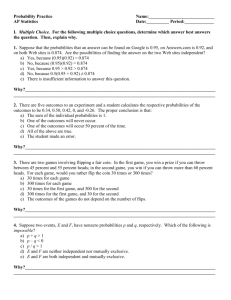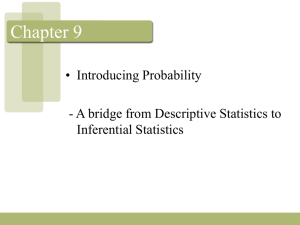Slide presentation
advertisement
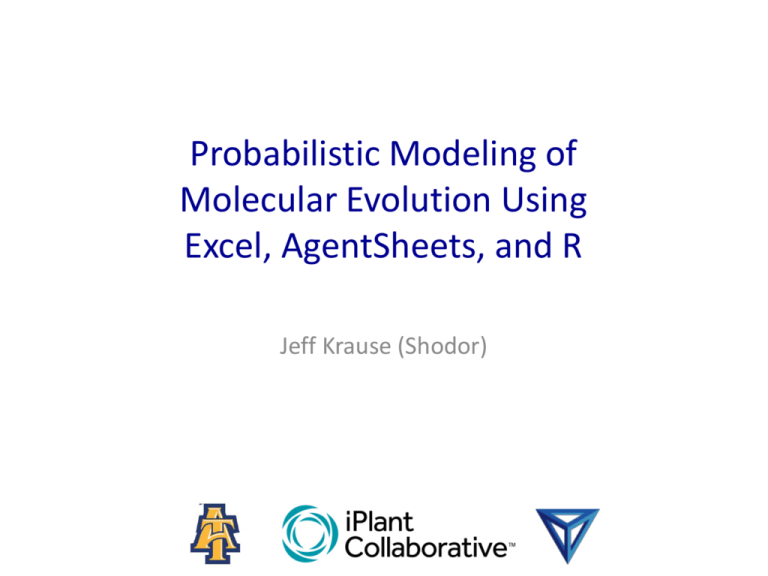
Probabilistic Modeling of
Molecular Evolution Using
Excel, AgentSheets, and R
Jeff Krause (Shodor)
Biological Sequence Space is Discrete
• Probability theory is crucial to understanding sequences
• Furthermore, metrics and algorithms for analyzing sequences
are statistical
Sequence Comparison:
Similarity/Distance
CAGTTAGCT
C
CATTAAGCT
C= # of differences in aligned positions
Proportional distance (p)
p = 2 differences in 10 positions
p = 0.2
Character Evolution
in Biological Sequences
CAGTTAGCT
C
||+|+||+||
CATTCAGAT
C
||||+||+||
CATTAAGCT
Probabilistic Modeling
of Sequence Evolution
• During replication (and recombination), errors occur
– Substitution, insertion, deletion, inversion, translocation, …
• Different types of errors have different chances of occurring,
but they can all be considered to happen randomly
• To develop models we need data to indicate how often each
type of error occurs
• Use observed frequencies and our understanding of the
mechanism of error occurrence to estimate probabilities of
errors
Stochastic Modeling of Sequences …
and More
• Yesterday we talked about dynamic modeling with difference
equations and rates of change
• Instead of thinking in terms of rate or proportion per unit
time, we could think in terms of probability of occurring
within a time-step
• So all of our dynamic models yesterday could be modeled
probabilistically
Probability Terms – Part I
• Trial – A single occurrence of a random process (e.g. a single
coin toss, or roll of a die)
• Outcome – The result of a trial (e.g. “heads” or “tails”)
• Probability – The chance of a random outcome occurring (e.g.
p(heads)=0.5, p(3)=1/6)
• Frequency – The number of occurrences of an outcome
• Relative frequency – Number of occurrences of an outcome
divided by the total number of trials
Probability Terms – Part II
• Event – A grouping of multiple outcomes (e.g. “roll an odd
number”, “roll less than 5”)
• Independent – The probability of an outcome is not
influenced by the outcomes of previous trials
• Multiplication rule – The probability that two independent
outcomes will occur is the product of their individual
probabilities (e.g. “toss two heads”, “roll is odd and <= 4)
Coin Toss
•
•
•
•
•
Create an Excel worksheet that conducts 10, 100, or 1000 trials of a coin toss
Tally the frequency of heads for each number of trials
Is it a fair coin? How do you know.
Variation in composition vs sample size
Degree of variation with sample size (range or difference between (max – min)
3 of heads
– Probably smaller with small sample sizes since sample size limits range
– Larger sample size makes variation across larger range possible
•
Proportional variation vs sample size
– Much larger for small samples since small differences in observed frequency have larger
effect when divided by small denominator of small sample
•
•
•
Probability of a given sequence of outcomes – multiplication rule multiple
independent events
Permutations – 2n different n-length sequences
Probability of event specifying sequence composition – enumerate
permutations and sum probabilities of events matching criteria, this is the
addition rule
Die Roll
• Is it a fair die? How do you know?
• Event probabilities for single trial
– p(odd), p(odd and < 5)
• Event probabilities for two trial events
– p(2,5), p(2,5 in any order), p(sum is 7) – (use plop-it)
• Union and intersection – explore addition rule and mutual
exclusive, as well as multiplication rule and independence
• Probability of a given sequence of length n = 6n
Probability Terms – Part III
• Union – The event that either or both of two events will occur on a
trial (e.g. the union of “odd” and “>4” is “1,3,5,6”)
• Mutually exclusive – Two events are mutually exclusive if they can’t
occur simultaneously (e.g. “roll an even number” and “roll an odd
number”)
• Addition rule – The probability of an event consisting of mutually
exclusive outcomes is the sum of the probabilities of the outcomes
(e.g. p(heads,tails) = p(heads) + p(tails)
• Complement – The complement to any event includes all possible
outcomes not in the event (e.g. “not heads”, “not 5”). The
probability of the complement is ( 1 – the probability of the event)
• Exhaustive – The set of all possible outcome, the probability must
sum to 1
Molecular Evolution and Phylogenetics
• Biology basics
– Central dogma: DNA -> RNA -> protein
– DNA replication and processing can lead to changes in DNA composition
• Metrics of distance
– Observed substitution frequencies
• “How often do we see A replaced with C”
– Distance based on evolutionary model
• “How many events separate these two sequences”
• Markov Models of Sequence Evolution
– Markov process – future state only depends on current state, not how it
got there
– Molecular genetic mechanisms at multiple scales with distinct
probabilities
• Single site events – sequences
• Events at larger scales
Nucleotide substitution:
Jukes-Cantor model
Substitution rates are equal
Nucleotides are in equal abundance
A C G T
C C A T G
Markov process
AC
GT
A
C
G
T
-3a a
a
a
a -3a a
a
a
a -3a a
a
a
a -3a
Rate matrix = M = {mij}
Simulating Jukes-Cantor
sequence evolution
• One nucleotide per sequence position
– Simulating change as finite difference using rate equation would give
fractional abundances at each position (population)
• Need to convert matrix of rates to transition probabilities
P(t) = {pij(t)} = eMt
Simulating Jukes-Cantor
sequence evolution
P(t) =
p0(t)
p1(t)
p1(t)
p1(t)
p1(t)
p0(t)
p1(t)
p1(t)
p1(t)
p1(t)
p0(t)
p1(t)
p1(t)
p1(t)
p1(t)
p0(t)
with
{
p0(t) = (1 + 3e-4at) / 4
p1(t) = (1 - e-4at) / 4
Since each row sums to one, only one expression is needed
Jukes-Cantor models
• AgentSheets
– Cell lineage tree
• Excel
– Cell lineage tree
– two sequence distance
– Probability vs. time
• R
– Cell lineage tree vs. phylogenetic reconstruction
References
Felsenstein, J. (2003). Inferring Phylogenies (2nd ed.). Sinauer
Associates.
Nielsen, R. (2005). Statistical Methods in Molecular Evolution
(1st ed.). Springer.
Yang, Z. (2006). Computational molecular evolution (p. 357).
Oxford University Press.


